... neuere Einträge
Donnerstag, 28. April 2011
Donnerstag, 28. April 2011
Day 54: China: Hetian – City of Jade, Silk and Carpets
In one of my last entries I had already mentioned that Hetian was famous in history for its production of silk, jade and carpets. Despite the incredible heat in the city, I nevertheless decided to leave the hotel and find out whether the city can still be called the City of Jade, Silk and Carpets or not. Decide yourself - here is what I found:
Carpets
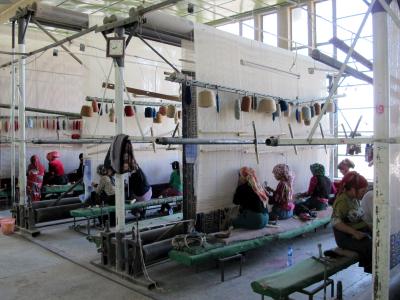
One of the carpet factories in Hetian

Carpet weaving
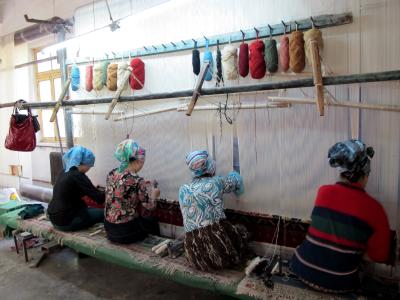

Some working steps before
Jade
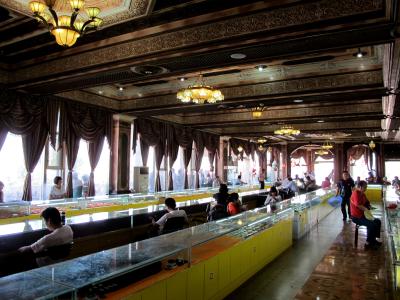
The Hetian jade trading centre

Merchant praising his jade

Jade in different shapes and colors. The pure white is the most precious.

Silk
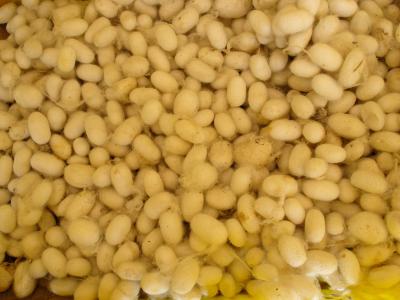
Silk cocoons

Silk threads
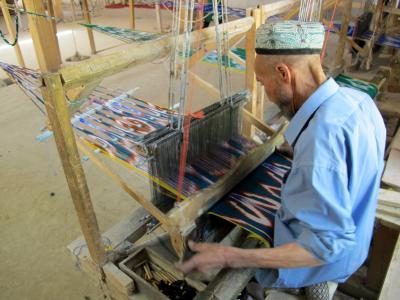
76 years old - started this job when he was 15.

Spindle - more than 200 years of history

Fast with the hands...
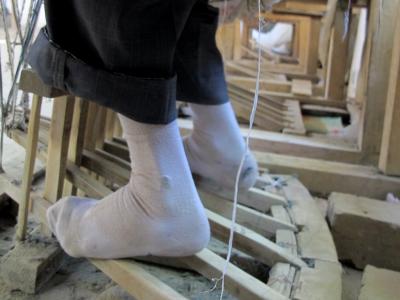
...and also with the feet
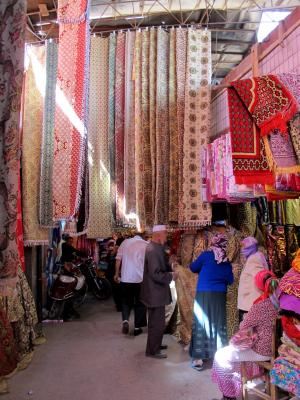
The finished fabrics are sold at the Bazaar
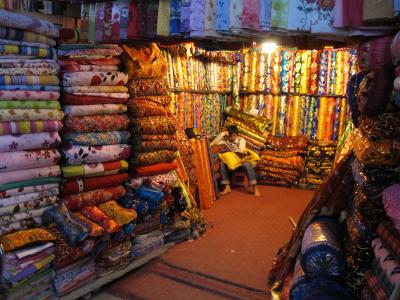
---------------------------------------------
Do you still remember “La Grand Dame” from Dushanbe? Well, I discovered a similar refreshing oasis right in the heart of Hetian. It is not French, the owner would probably call it Venetian. He wanted to call his Café “Marco Polo”, unfortunately he did not get the permission to do so. Now it is called “Marco’s Dream Café” (Well, I have to admit I would have also preferred Marco Polo, but it shouldn’t be the name of a place making you decide to go in). The Café was opened in 2007 by a Malaysian couple. Both of them, as well as their two little daughters, speak English without accent. When they came to Hetian, they worked for an American NGO, and later decided to open the Café. All of them are very friendly and usually come over for a chat. They offer Malay food, but also some Western things – I tried the chicken with ginger rice. Best of all was the desert, a chocolate strawberry cake and REAL coffee – soooo good!
I told the owner that I was really happy in this moment – Pilaf and meat on a stick since weeks already – I couldn’t stand it anymore. Now I would finally get a piece of good cake. “That’s just what I told the Chinese when they asked me why I would open a Western-style Café in Hetian. When western foreigners arrive in Hetian, they will long for western coffee and cake!” I have to say he was more than right…
For anyone who should ever make it to Hetian, please check out this place. It is located just around the corner of Tuanjie Square 团结广场. It is a little hidden, but you can recognize it by the small wooden coffee tables and chairs standing in front of their window. They will also be included in the next Lonely Planet.
Carpets

One of the carpet factories in Hetian

Carpet weaving


Some working steps before
Jade

The Hetian jade trading centre

Merchant praising his jade

Jade in different shapes and colors. The pure white is the most precious.

Silk

Silk cocoons

Silk threads

76 years old - started this job when he was 15.

Spindle - more than 200 years of history

Fast with the hands...

...and also with the feet

The finished fabrics are sold at the Bazaar

---------------------------------------------
Do you still remember “La Grand Dame” from Dushanbe? Well, I discovered a similar refreshing oasis right in the heart of Hetian. It is not French, the owner would probably call it Venetian. He wanted to call his Café “Marco Polo”, unfortunately he did not get the permission to do so. Now it is called “Marco’s Dream Café” (Well, I have to admit I would have also preferred Marco Polo, but it shouldn’t be the name of a place making you decide to go in). The Café was opened in 2007 by a Malaysian couple. Both of them, as well as their two little daughters, speak English without accent. When they came to Hetian, they worked for an American NGO, and later decided to open the Café. All of them are very friendly and usually come over for a chat. They offer Malay food, but also some Western things – I tried the chicken with ginger rice. Best of all was the desert, a chocolate strawberry cake and REAL coffee – soooo good!
I told the owner that I was really happy in this moment – Pilaf and meat on a stick since weeks already – I couldn’t stand it anymore. Now I would finally get a piece of good cake. “That’s just what I told the Chinese when they asked me why I would open a Western-style Café in Hetian. When western foreigners arrive in Hetian, they will long for western coffee and cake!” I have to say he was more than right…
For anyone who should ever make it to Hetian, please check out this place. It is located just around the corner of Tuanjie Square 团结广场. It is a little hidden, but you can recognize it by the small wooden coffee tables and chairs standing in front of their window. They will also be included in the next Lonely Planet.
Link
(0 Kommentare)
Kommentieren
Donnerstag, 28. April 2011
Day 53: China: Hetian – Change of plans
Yes, correctly – I am not in Qiemo as expected. When I went to the bus station in Minfeng in the morning for getting on a car to Qiemo, I was told that the street was closed due to heavy sandstorms and other reasons. I should wait until noon. Just about one hour later I was told that the street would not be opened again until at least the day after tomorrow and I should better return to Hetian. Well, what to do? In one of my earlier itineraries I had included Kuche on the northern Silk Road which is famous for its Buddhist Grottoes full of mural paintings – Kizil. Due to the time I took it out though. However, now I had to go back to Hetian and I did not know if or when I would be able to go to Qiemo. As I had other things on my plan, I just decided to continue my journey on the northern part of the Silk Road, taking a flight to Kuche and then continuing to Korla – bringing me back on the originally planned route. But before I would leave for Korla, I still had one day left in Hetian…

Back in Hetian

Back in Hetian
Link
(0 Kommentare)
Kommentieren
Dienstag, 26. April 2011
Dienstag, 26. April 2011
Day 52: China: Minfeng – Aliens, Donkeys and other happy stories
My day started at 9 o’clock Xinjiang time in Hetian (Khotian). I checked-out the hotel and took a cab to the eastern bus station. When I got there I was told that there were no buses heading for Minfeng today, only small cars. As they were only about 20 RMB more expensive this was not a big deal. I was the first passenger on this taxi, so I had to wait until the car was full – I sat about two hours in the burning sun until we got on the road…After a three hours ride through the open desert I arrived in Minfeng. As I got out of the car I was immediately surrounded by a knot of people, everyone staring at me, once in a while one of them said “See, it’s a foreigner! What does he do here?” Fortunately Minfeng is not a big town, according to one of its inhabitants just as big as his hand, so it was only a few steps to the hotel I had booked last night. Actually there are only two streets in this city and my hotel was located right at the intersection, down town so to say. It has the beautiful name “Very Happy Hotel” (好幸福宾馆), I think that was one of the reasons why I picked it. When I entered my room I even realized that there was internet which made me very happy!
Some of you might ask themselves why I stopped in this city right in the desert? Well, the main reason for this was a small museum which I found by chance on the internet – the “Niya Museum”.
The Ruins of the lost city Niya are located about 115 km north of Minfeng on the southern edge of the Tarim Basin. Numerous scriptures, sculptures, mummies and other archaeological finds such as architectural remains have been uncovered here. The Niya oasis was once a major commercial centre on the southern branch of the Silk Road where many caravans had to cut through on their way to the east or the west. I had really looked forward to seeing this museum. When I arrived in the hotel I asked the lady at the front desk about it. Unfortunately she had never heard about it. When I asked her about other interesting things to visit in the city she told me there is actually nothing to see. Well, I did not give up yet. I left the hotel, crossed the street, walked about 50 m in southern direction, and, et voilà, was standing in front of the museum…well actually in front of a tall fence surrounding the building. I was lucky again! I saw that the entrance was opened, so I just had to wait until someone eventually would come out which, happily, did not take long. A veiled lady in a long skirt came out, I frantically waved at her – I was lucky she did not call the local police – and came over to me. I explained her that I came from very far away and that I would really love to see the exhibition. She told me I had to wait for the director of the museum – only he could decide on this. Well, I was very positive and waited in front of the gate. About half an hour later the director really came. As I was about to fall on my knees and try to convince him to let me in, he just waved at me and said “LAI!” (Come!). That was easy! Well, I was the only visitor since weeks. The director went to his office to get the key, he opened the doors to the holy rooms and the alarm set off. Hmmm! The director stayed very calm, he just went back to his office and turned off the alarm – he seemed to have practiced this procedure before. He came back and said “NI KAN!” (Take a look!) Well, I entered the exhibition and another veiled lady was following me step by step – after about half an hour she switched off all the lights again and asked me to leave…at least I got this half an hour!
What to do now? I wandered through the streets and almost caused several accidents as cyclists fell off their bikes when they saw me. I thought I should better go inside, so I went into an internet-café. Unfortunately people without a Chinese ID are not allowed to surf in Minfeng County so I eventually ended up back in the hotel where I stayed until it got dark outisde. As I was looking for a nice restaurant, all the people sitting on the streets stopped talking instantly as I passed them…some of them sad “The foreigner again!”. I finally found this small place across the street. I went in, the people stopped talking and I sat down immediately. The staff was really surprised and did not know how to handle me. I decided to say something in Chinese to break the ice. From now on everything was okay. Many questions came from the other tables “What the hell are you doing in Minfeng? There is nothing to do here…there is a museum? Never heard about it.” Which working unit are you from? I decided to tell them that I came from the archaeological working unit – they were quite impressed! Ah, you are one of those guys who plunder tombs…you must be rich, having lots of precious things at home. As I was eating I enjoyed the atmosphere in the restaurant – people were spitting on the ground, they were drinking and shouting at the waitress to hurry up…just like in the old days!
After dinner I was still the witness of a donkey-cart accident – happily nothing happened to the animal…

"Very Happy Hotel"
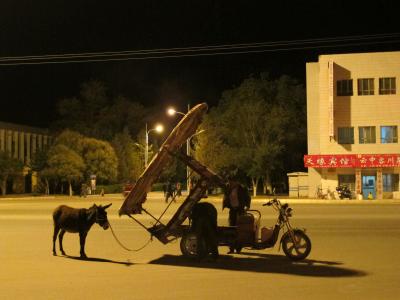
The Donkey
Some of you might ask themselves why I stopped in this city right in the desert? Well, the main reason for this was a small museum which I found by chance on the internet – the “Niya Museum”.
The Ruins of the lost city Niya are located about 115 km north of Minfeng on the southern edge of the Tarim Basin. Numerous scriptures, sculptures, mummies and other archaeological finds such as architectural remains have been uncovered here. The Niya oasis was once a major commercial centre on the southern branch of the Silk Road where many caravans had to cut through on their way to the east or the west. I had really looked forward to seeing this museum. When I arrived in the hotel I asked the lady at the front desk about it. Unfortunately she had never heard about it. When I asked her about other interesting things to visit in the city she told me there is actually nothing to see. Well, I did not give up yet. I left the hotel, crossed the street, walked about 50 m in southern direction, and, et voilà, was standing in front of the museum…well actually in front of a tall fence surrounding the building. I was lucky again! I saw that the entrance was opened, so I just had to wait until someone eventually would come out which, happily, did not take long. A veiled lady in a long skirt came out, I frantically waved at her – I was lucky she did not call the local police – and came over to me. I explained her that I came from very far away and that I would really love to see the exhibition. She told me I had to wait for the director of the museum – only he could decide on this. Well, I was very positive and waited in front of the gate. About half an hour later the director really came. As I was about to fall on my knees and try to convince him to let me in, he just waved at me and said “LAI!” (Come!). That was easy! Well, I was the only visitor since weeks. The director went to his office to get the key, he opened the doors to the holy rooms and the alarm set off. Hmmm! The director stayed very calm, he just went back to his office and turned off the alarm – he seemed to have practiced this procedure before. He came back and said “NI KAN!” (Take a look!) Well, I entered the exhibition and another veiled lady was following me step by step – after about half an hour she switched off all the lights again and asked me to leave…at least I got this half an hour!
What to do now? I wandered through the streets and almost caused several accidents as cyclists fell off their bikes when they saw me. I thought I should better go inside, so I went into an internet-café. Unfortunately people without a Chinese ID are not allowed to surf in Minfeng County so I eventually ended up back in the hotel where I stayed until it got dark outisde. As I was looking for a nice restaurant, all the people sitting on the streets stopped talking instantly as I passed them…some of them sad “The foreigner again!”. I finally found this small place across the street. I went in, the people stopped talking and I sat down immediately. The staff was really surprised and did not know how to handle me. I decided to say something in Chinese to break the ice. From now on everything was okay. Many questions came from the other tables “What the hell are you doing in Minfeng? There is nothing to do here…there is a museum? Never heard about it.” Which working unit are you from? I decided to tell them that I came from the archaeological working unit – they were quite impressed! Ah, you are one of those guys who plunder tombs…you must be rich, having lots of precious things at home. As I was eating I enjoyed the atmosphere in the restaurant – people were spitting on the ground, they were drinking and shouting at the waitress to hurry up…just like in the old days!
After dinner I was still the witness of a donkey-cart accident – happily nothing happened to the animal…

"Very Happy Hotel"

The Donkey
Dienstag, 26. April 2011
Day 50/51: China: Hetian (Khotan) – Trading centre since ancient times
The present-day city of Hetian (Khotan) was once a Buddhist kingdom located on the southern edge of the Taklamakan desert and one of the major points on the southern Silk Road. The city was built on an oasis, known for its many mulberry groves allowing the production and export of silk and silk rugs. Besides, the city became famous for the most precious jade found in China. Many merchants crossed and stopped in this city exchanging their goods from the east and the west. As I came into the city, I realized that it hadn’t lost much of its charm – still, the city is dominated by merchants. I was lucky, as I got to Hetian on Monday, the day when one of the largest bazaars in China is taking place here.

Waiting for customers

Cut and go
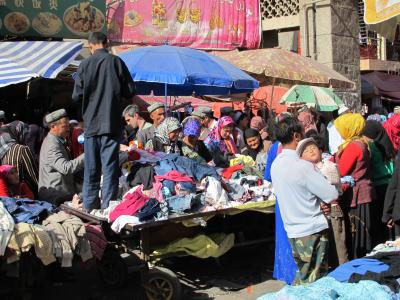
Bargain bin Hetian-style
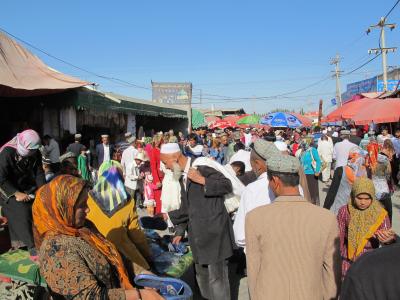
People everywhere

Xinjiang Province - famous for its watermelons

Street dentist

Tired after a long working day
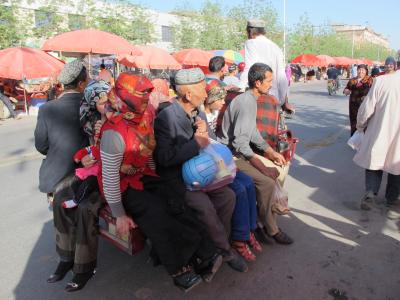
After-work rush-hour

Waiting for customers

Cut and go

Bargain bin Hetian-style

People everywhere

Xinjiang Province - famous for its watermelons

Street dentist

Tired after a long working day

After-work rush-hour
Link
(0 Kommentare)
Kommentieren
Sonntag, 24. April 2011
Sonntag, 24. April 2011
New blog-address and itinerary
Dear all, unfortunately I couldn't use the old blog-website in China. Here is the new website which seems to work. I hope you will enjoy the following entries...
For all of those who are wondering where I am at the moment and where I will go next, here the tentative itinerary for my China trip:
Urumqi 乌鲁木齐
Yinchuan 银川
Tongxin 同心
Guyuan 固原
Kashgar 喀什
Shache/Yarkand 莎车
Hetian/Khotan 和田
Minfeng 民丰
Hetian/Khotan 和田
Kuche 库车
Korla 库尔勒
Dunhuang 敦煌
Jiuquan 酒泉
Wuwei 武威
Lanzhou 兰州
Beijing 北京
Qingzhou 青州
Luoyang 洛阳
Xi'an 西安
Beijing 北京
For all of those who are wondering where I am at the moment and where I will go next, here the tentative itinerary for my China trip:
Urumqi 乌鲁木齐
Yinchuan 银川
Tongxin 同心
Guyuan 固原
Kashgar 喀什
Shache/Yarkand 莎车
Hetian/Khotan 和田
Minfeng 民丰
Hetian/Khotan 和田
Kuche 库车
Korla 库尔勒
Dunhuang 敦煌
Jiuquan 酒泉
Wuwei 武威
Lanzhou 兰州
Beijing 北京
Qingzhou 青州
Luoyang 洛阳
Xi'an 西安
Beijing 北京
Link
(0 Kommentare)
Kommentieren
Sonntag, 24. April 2011
Day 49: China: Shache (Yarkand)
I am sharing my taxi to Shache with three other Uighur people. One of them is an older lady of about 60 years. She worked as a teacher so her Chinese is very good. She is very interested in me and asks me dozens of questions, about my life, my studies and my family. She tells me about Rabeya K. and she knows that the Uighur have some kind of organization in Munich. She thinks it is great that our chancellor is a woman and that so many different peoples live in Germany.
The Uighur lady has four children, three daughters and a son. Her son had died in a car crash in 2006 when he was heading home for Spring Festival. His wife and their two sons survived. The oldest son, now 13 years old, just looks like his father and their wish is to send him on a good university for a better life.
All in a sudden the lady tells me that she wants to be my Uighur mother, if I had any problems I should just call her. She invites me to her house to have dinner with her and her family. She especially would love me to become good friends with her oldest grandson. If he should ever make it to Germany, he could call me.
This was quite a weird conversation!
While I am sitting on a bench on this large square in the centre of Shache, I get to know yet another person. He is 14 years old, Uighur, and his name is Alisher. I am totally struck by his English which he learned from his mother who is an English teaching at Shache Middle School. He asks me if he can join me a little while – he would love to show me around in HIS Shache. I say okay and we start walking. He takes me to this beautiful park and he is obviously proud to walk beside me. The kids in his age come by, they stare at me and usually don’t say a word. Some of them ask Alisher where I come from and what we are doing. Alisher’s dream is to enter a good university, become an interpreter and get in touch with many different people. He takes me to the old city, explains me some things we are seeing on our way. At the same time he wants to know everything about the Western way of life. He plays the traditional Uighur guitar and he likes reading news on the internet. He feels very sorry about the tragedy which happened in Japan and he asks me about the recent developments in Libya.
”I bet you have never met such a friendly person in your life like me, wanting to show you around in his hometown, have you?” Well, indeed, I think it is the first time in my life to meet such an incredible young person…
Arrived in Shache (Yarkand):
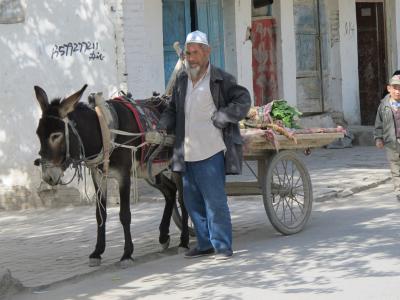
Donkey carts ruling the streets

After a long day - finally some rest
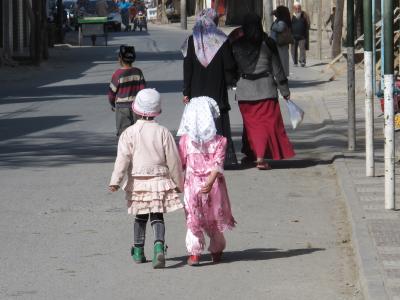
Saturday afternoon walk
The Uighur lady has four children, three daughters and a son. Her son had died in a car crash in 2006 when he was heading home for Spring Festival. His wife and their two sons survived. The oldest son, now 13 years old, just looks like his father and their wish is to send him on a good university for a better life.
All in a sudden the lady tells me that she wants to be my Uighur mother, if I had any problems I should just call her. She invites me to her house to have dinner with her and her family. She especially would love me to become good friends with her oldest grandson. If he should ever make it to Germany, he could call me.
This was quite a weird conversation!
While I am sitting on a bench on this large square in the centre of Shache, I get to know yet another person. He is 14 years old, Uighur, and his name is Alisher. I am totally struck by his English which he learned from his mother who is an English teaching at Shache Middle School. He asks me if he can join me a little while – he would love to show me around in HIS Shache. I say okay and we start walking. He takes me to this beautiful park and he is obviously proud to walk beside me. The kids in his age come by, they stare at me and usually don’t say a word. Some of them ask Alisher where I come from and what we are doing. Alisher’s dream is to enter a good university, become an interpreter and get in touch with many different people. He takes me to the old city, explains me some things we are seeing on our way. At the same time he wants to know everything about the Western way of life. He plays the traditional Uighur guitar and he likes reading news on the internet. He feels very sorry about the tragedy which happened in Japan and he asks me about the recent developments in Libya.
”I bet you have never met such a friendly person in your life like me, wanting to show you around in his hometown, have you?” Well, indeed, I think it is the first time in my life to meet such an incredible young person…
Arrived in Shache (Yarkand):

Donkey carts ruling the streets

After a long day - finally some rest

Saturday afternoon walk
Link
(0 Kommentare)
Kommentieren
Sonntag, 24. April 2011
Day 48: China: Kashgar – Abudu
As I stand in front of one of the showcases of the Kashgar Museum, suddenly a guy a little younger than me comes closer. He greets me in a very good English, asks me where I come from and what I do in Kashgar. We start talking and somehow spent the rest of the day together. His name is Abudu, he is 24 years old and was born in Hetian (Khotan). He studied architecture at North-western University in Xi’an. After his graduation last year, he had received a job-offer in the Kashgar Museum – that’s how he got here. He tells me that he should actually be attending a workshop at this moment, but he was bored to death. When his colleague told him that a foreigner was visiting the museum, he decided to leave and spent the day more interesting. He is happy to have a permanent job, however, he feels bored and fears to be stuck with this situation for the rest of his life. He envies all foreigners who seem to be more independent according to his point of view. Actually he would love to spent some time abroad, improve his English and become a specialist on Uighur architecture. The reality seems different: he feels pressured by his family – they want him to get married as soon as possible, get a child, a house and a car – all in all, to settle down. I later learn that Abudu is dating a girl for about one month. He likes her and already thinks about getting married. He has just signed a contract for the purchase of an apartment which he is going to pay with a mortgage – it should take about 15 years until everything is paid off. Next month he will get a car – his dad is going to lend him the money. I was surprised about all of this information and happy to lead the life I live…
Some impressions from Kashgar:
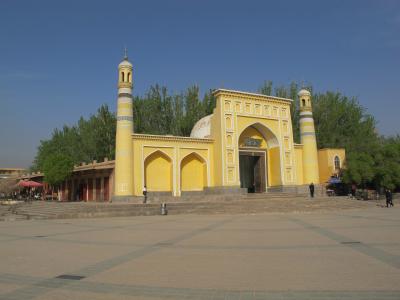
Idkah Mosque - the largest mosque in China

What's for dinner tonight?

Chairman Mao residing over the city
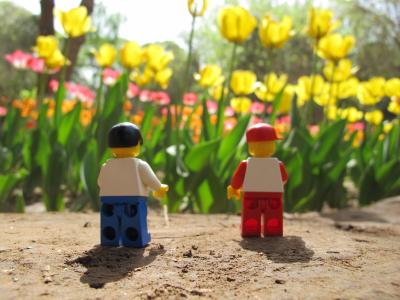
Tulip season in Kashgar

Handmade pottery in the old town of Kashgar

Kungfu-kid fighting for a shot

Mysterious old town

Traders everywhere
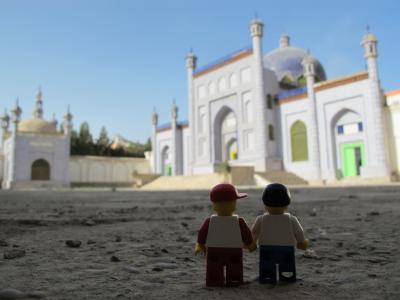
Tomb of Yusupu Hasi Hajipu
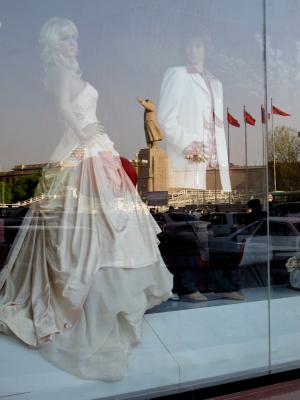
Mao-style wedding
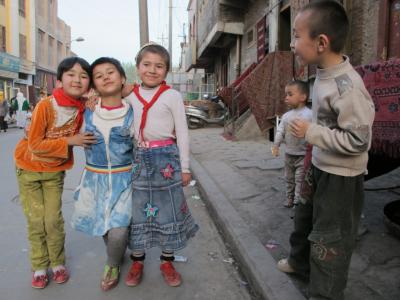
Kids eagering for a photo
Some impressions from Kashgar:

Idkah Mosque - the largest mosque in China

What's for dinner tonight?

Chairman Mao residing over the city

Tulip season in Kashgar

Handmade pottery in the old town of Kashgar

Kungfu-kid fighting for a shot

Mysterious old town

Traders everywhere

Tomb of Yusupu Hasi Hajipu

Mao-style wedding

Kids eagering for a photo
Link
(0 Kommentare)
Kommentieren
Sonntag, 24. April 2011
Day 47: China: Guyuan – Kashgar
One of my typical itineraries these days...
5:45 a.m.: Getting up
6:15 a.m.: Check-out
6:30 a.m.: Breakfast – we get spicy noodle soup with large chunks of mutton
7:00 a.m.: Leaving Guyuan for Yinchuan
11:00 a.m.: Arrival at Hedong airport, Yinchuan. My flight leaves at 15:45 p.m, that of the others at 13:30 p.m. It is too early to check-in my luggage, so I decide to put it into a locker as we still have to meet the director of the archaeological institute who insists to have lunch with us somewhere close to the airport.
11:30 a.m. – 12:30 p.m.: Lunch in a small restaurant at the bank of the Yellow River
12:50 p.m.: Back at the airport and saying good-bye to the others. Picking up my bag from the locker. Waiting until 13:45 p.m. until I can finally check-in.
15:45 – 18:30 p.m.: Flight to Urumqi. I am sitting next to some strange guy from a village in Gansu who flies for the first time in his life. Did I mention that this guy had an extremely bad breath and that he was almost sitting on my lap as he always wanted to look out of the window? Every once in a while he came so close that I could feel his breath in my ears – I almost passed out! Whenever he wants to start a conversation, he is shouting at me – I am the first foreigner he is talking to in his life. Moreover, German cars and soccer are the best in this world…
18:30 – 19:30 p.m.: Claiming my luggage and changing the terminal
19:50 p.m.: Check-in
20:20 – 22:00 p.m.: Flight to Kashgar. In order to avoid strange conversations on this flight, I decide to read the “Global Times” newspaper. I read the title story on Prince William’s and Kate Middleton’s wedding.
22:00 – 23:00 p.m.: Arrival in Kashgar at 22:00 o’clock Beijing time, 20:00 o’clock Xinjiang time. It is just about to get dark. I am taking the taxi to Qinbakh Hotel, the former British Consulate, and listen to a Uighur taxi driver complaining about the Chinese settling in Kashgar.
23:30 p.m.: Washing clothes, writing some text for the next blog-entry and making a plan for tomorrow.
1:00 a.m.: Going to bed…

Flight over the Taklamakan Desert
5:45 a.m.: Getting up
6:15 a.m.: Check-out
6:30 a.m.: Breakfast – we get spicy noodle soup with large chunks of mutton
7:00 a.m.: Leaving Guyuan for Yinchuan
11:00 a.m.: Arrival at Hedong airport, Yinchuan. My flight leaves at 15:45 p.m, that of the others at 13:30 p.m. It is too early to check-in my luggage, so I decide to put it into a locker as we still have to meet the director of the archaeological institute who insists to have lunch with us somewhere close to the airport.
11:30 a.m. – 12:30 p.m.: Lunch in a small restaurant at the bank of the Yellow River
12:50 p.m.: Back at the airport and saying good-bye to the others. Picking up my bag from the locker. Waiting until 13:45 p.m. until I can finally check-in.
15:45 – 18:30 p.m.: Flight to Urumqi. I am sitting next to some strange guy from a village in Gansu who flies for the first time in his life. Did I mention that this guy had an extremely bad breath and that he was almost sitting on my lap as he always wanted to look out of the window? Every once in a while he came so close that I could feel his breath in my ears – I almost passed out! Whenever he wants to start a conversation, he is shouting at me – I am the first foreigner he is talking to in his life. Moreover, German cars and soccer are the best in this world…
18:30 – 19:30 p.m.: Claiming my luggage and changing the terminal
19:50 p.m.: Check-in
20:20 – 22:00 p.m.: Flight to Kashgar. In order to avoid strange conversations on this flight, I decide to read the “Global Times” newspaper. I read the title story on Prince William’s and Kate Middleton’s wedding.
22:00 – 23:00 p.m.: Arrival in Kashgar at 22:00 o’clock Beijing time, 20:00 o’clock Xinjiang time. It is just about to get dark. I am taking the taxi to Qinbakh Hotel, the former British Consulate, and listen to a Uighur taxi driver complaining about the Chinese settling in Kashgar.
23:30 p.m.: Washing clothes, writing some text for the next blog-entry and making a plan for tomorrow.
1:00 a.m.: Going to bed…

Flight over the Taklamakan Desert
Link
(0 Kommentare)
Kommentieren
Sonntag, 24. April 2011
Day 46: China: Yinchuan to Guyuan
Today we are leaving very early in the morning as we are heading south to Guyuan. We are passing the Yellow River flowing through the brown-reddish landscape. The air is full of sand today, making it hard to keep the eyes open. Our first stop is Tongxin, a small city almost completely consisting of Hui people. Like most of the other cities we are passing on our way, this one as well is dominated by a large mosque. The women wear the blue kind of hat/scarf and a mouth cover, making it difficult to recognize anything of their faces. The mostly bearded men wear a white skull-cap plus one of those large, old-fashioned sunglasses which I know from the Panjiayuan antique market in Beijing. They make their way through the city on their bikes. Here and there are remains of the ancient city, including the city wall. Most of the people are curious and they stare at us when we walk past them. Not many foreign tourists make their way to this city in the south of Ningxia.
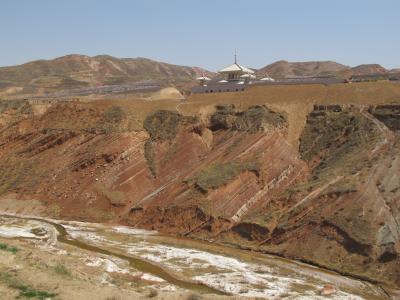
The new museum at Xumishan Grottoes

View from the top of Xumi Mountain

Buddhas from the Northern dynasties period
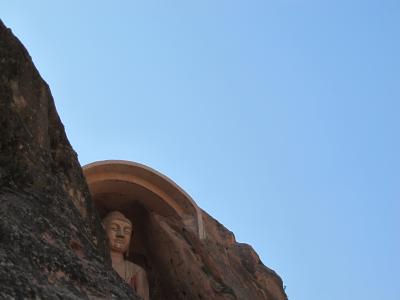
Large Buddha guarding Xumi Mountain

Muslim Mausoleum close to Guyuan

Countryside of Guyuan County

The new museum at Xumishan Grottoes

View from the top of Xumi Mountain

Buddhas from the Northern dynasties period

Large Buddha guarding Xumi Mountain

Muslim Mausoleum close to Guyuan

Countryside of Guyuan County
Link
(0 Kommentare)
Kommentieren
Sonntag, 24. April 2011
Day 45: China: Yinchuan
My cell-phone rings at 7 o’clock in the morning, thirty minutes earlier than I had actually planned to get up. As I answer, a loud voice is shouting at me from the other side of the line “Xiao Wei (Little Wei), I arrived earlier. Please come down so we can leave.” SHOOT! I jump out of my bed, rush to the bathroom where I take a five minute shower, brush my teeth, put on my clothes and rush down to the lobby where my driver is already waiting. Whenever a day starts like this, it is usually already over for me. Anyway, I decided to be happy today. Five minutes on the car and we already made our first stop – Chinese breakfast: rice soup, deep-fried dough sticks (Youtiao) and a glass of soy milk. I gulped down the food and went back on the car.
Today I was going to visit the imperial tombs of the Western Xia Dynasty, approximately thirty minutes out of Yinchuan. On the way I listened to the daily honking concert and I observed the scenery we were crossing. Like most of the Chinese drivers, this one as well wanted to know many things about me and Germany. Moreover, he was interested in the German point of view on the latest political happenings in and out of China.
As we were talking, the tombs in the shape of pyramids were coming closer from the distance. As we reached the park, we entered from the back. I was introduced to some people, shook several hands and finally was released. I had two hours time to explore the area…
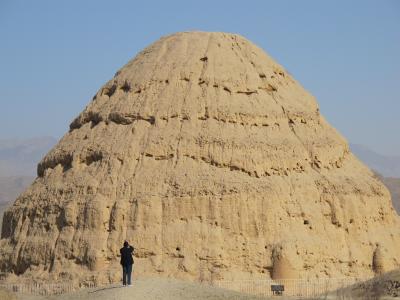

Today I was going to visit the imperial tombs of the Western Xia Dynasty, approximately thirty minutes out of Yinchuan. On the way I listened to the daily honking concert and I observed the scenery we were crossing. Like most of the Chinese drivers, this one as well wanted to know many things about me and Germany. Moreover, he was interested in the German point of view on the latest political happenings in and out of China.
As we were talking, the tombs in the shape of pyramids were coming closer from the distance. As we reached the park, we entered from the back. I was introduced to some people, shook several hands and finally was released. I had two hours time to explore the area…


Link
(0 Kommentare)
Kommentieren
Sonntag, 24. April 2011
Day 44: China: Yinchuan – Old versus New
Part of my program in Yinchuan was the visit of the Provincial Museum of Ningxia which had been opened in 2008. Just like all the other new museum complexes in China, this one as well is the result of a megalomaniac project featuring the latest high-tech fashion. Several thousand people visit the museum every day. A brigade of cleaners is responsible for sweeping the floor as shiny as possible, making you feel like walking on a mirror. I was especially impressed by the exhibition on the history of the Communists in Ningxia, a large installation of a red ribbon floating through the different halls, here and there a sculpture of a heroic figure making your heart beat higher and higher.
The museum is located in the newly built city centre, crossed by wide streets and filled with monotonous high rises, each of them offering space for about one hundred families. The new library has just been opened and the theatre will be inaugurated in several months. Recently planted trees bring a light green colour into the otherwise grey and white environment. What is missing here are the people, still seeming to prefer the old charming city which presents a completely different face of Yinchuan, offering a large variety of eateries, shops and parks. The centre of it is Nanguan Mosque, one of the largest in China and the first one which was open for tourists. As I walk through the entrance gate, I am welcomed by an old man. He has a long grey beard and like most of the other Hui, he wears the white skull-cap on his head. He shakes my hand and tells me to take a look into the mosque. It is prayer time! People are rushing to the entrance where they take off their shoes. They quietly proceed into the mosque and join the other people already absorbed in prayer, headed by the priest standing in front of the prayer niche. As I walk through the garden a veiled lady approaches me. She cannot believe that I speak her language. She speaks extremely slowly and asks me over and over again if I can understand her words. She wants to tell me something about the history of the mosque as well as the peculiarities of the Hui in Ningxia.
“Where you come from, Muslim people are turned to the east during prayer. China lies east of Mecca, so we pray to the west…The dream of us is to make a Hajj to Mecca once in our lives. Every year, there is a special flight connection from Yinchuan directly to Mecca. We have to apply very early in advance to get a seat – 2000 of us get to go each time. Only retired people above fifty can go. All the expenses have to be paid by the pilgrim himself, otherwise the pilgrimage does not count…” I ask her which one of the almost 2000 mosques all over China she likes best. “Of course ours – the colours and the shape of the building are beautiful, just like the mosques in Arabia.” Suddenly her son turns up. He seems very shy at the beginning, but he is excited to see the foreigner. He shows me two large models of Mecca and Medina, both of them equipped with fancy lighting which he switches on for me. When I want to leave the mosque, the old man from the beginning comes over again for a chat. He shows me his cell-phone on which he had saved photos taken together with other visitors. I am also part if this gallery now …
The museum is located in the newly built city centre, crossed by wide streets and filled with monotonous high rises, each of them offering space for about one hundred families. The new library has just been opened and the theatre will be inaugurated in several months. Recently planted trees bring a light green colour into the otherwise grey and white environment. What is missing here are the people, still seeming to prefer the old charming city which presents a completely different face of Yinchuan, offering a large variety of eateries, shops and parks. The centre of it is Nanguan Mosque, one of the largest in China and the first one which was open for tourists. As I walk through the entrance gate, I am welcomed by an old man. He has a long grey beard and like most of the other Hui, he wears the white skull-cap on his head. He shakes my hand and tells me to take a look into the mosque. It is prayer time! People are rushing to the entrance where they take off their shoes. They quietly proceed into the mosque and join the other people already absorbed in prayer, headed by the priest standing in front of the prayer niche. As I walk through the garden a veiled lady approaches me. She cannot believe that I speak her language. She speaks extremely slowly and asks me over and over again if I can understand her words. She wants to tell me something about the history of the mosque as well as the peculiarities of the Hui in Ningxia.
“Where you come from, Muslim people are turned to the east during prayer. China lies east of Mecca, so we pray to the west…The dream of us is to make a Hajj to Mecca once in our lives. Every year, there is a special flight connection from Yinchuan directly to Mecca. We have to apply very early in advance to get a seat – 2000 of us get to go each time. Only retired people above fifty can go. All the expenses have to be paid by the pilgrim himself, otherwise the pilgrimage does not count…” I ask her which one of the almost 2000 mosques all over China she likes best. “Of course ours – the colours and the shape of the building are beautiful, just like the mosques in Arabia.” Suddenly her son turns up. He seems very shy at the beginning, but he is excited to see the foreigner. He shows me two large models of Mecca and Medina, both of them equipped with fancy lighting which he switches on for me. When I want to leave the mosque, the old man from the beginning comes over again for a chat. He shows me his cell-phone on which he had saved photos taken together with other visitors. I am also part if this gallery now …
Link
(0 Kommentare)
Kommentieren
